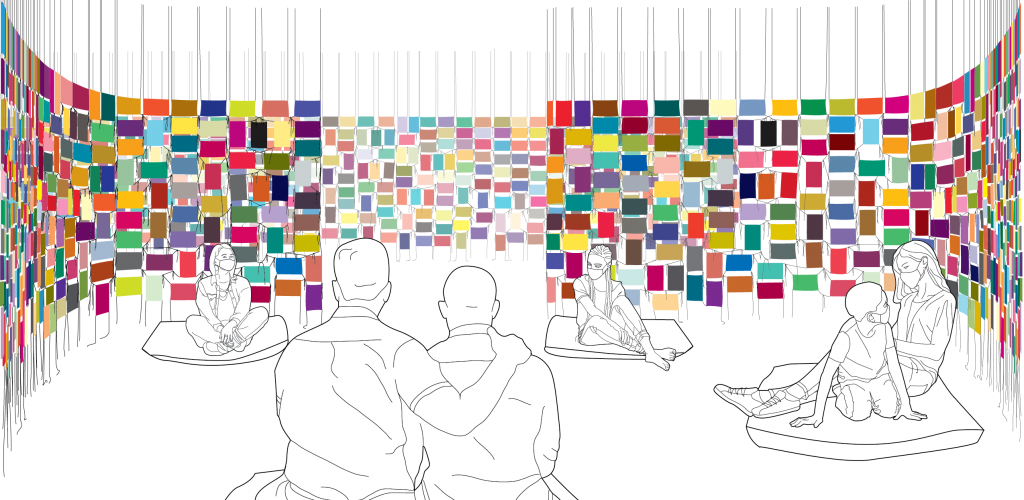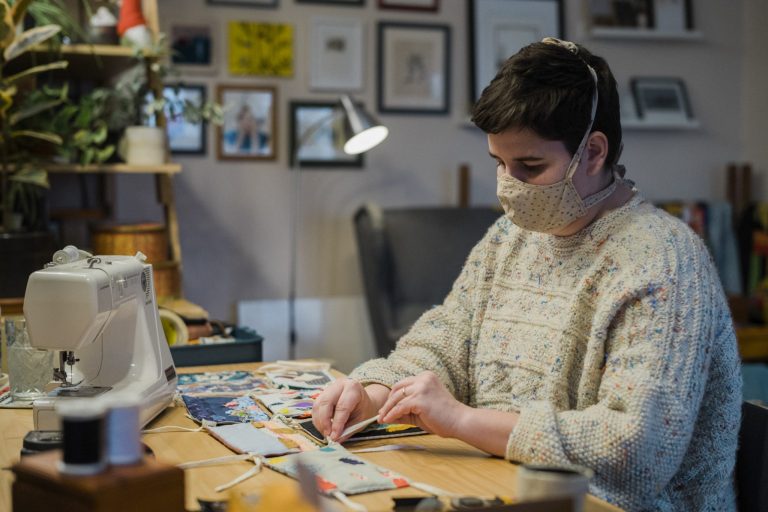A local University of Waterloo architecture student, Brenda Reid, created From Behind the Mask. The project is a community art initiative — part of her grad thesis on making space for pain, resilience and care within our community.
The goal of the project is “… to come together, while apart, and make something that will remain as a memorial, acknowledge inequality, and act as a starting point for healing,” Reid said.
Even before the pandemic, Reid started thinking about how the community interacts with public spaces and quilting as a practice of care, and how she could relate those two things to architecture for her thesis.
“Looking at women’s work and the communities around care, quilting bees and all these things — I feel like there’s a lot to learn from groups that have been marginalized,” Reid said.
Then the pandemic hit. With the restrictions and closures, Reid spent time outside walking around Kitchener taking photos and noticing changes to the city. That got her thinking about different ways the community was interacting and using public space.
“I was like, wow, people are figuring this out. They’re caring for each other. And so, while I was doing that, I was also photographing all these signs and sidewalk chalk messages, and all these different things and ways people were communicating with each other in the neighbourhoods,” Reid said.
Reid wanted to learn more about how to construct her own quilt and turned to her mother for help, who learned to quilt from her father’s mother. Thinking of ways to tie things all together (pun intended) Reid started researching other community quilts.
“My prof just casually said, ‘it’d be cool if the community was involved’ and then I was looking at some other community quilts, especially The NAMES Project AIDS Memorial Quilt, which is actually the world’s largest community art project,” Reid said.
With COVID-19 restrictions, Reid wondered how she could tackle getting everyone to work on a collective, large scale quilt strategically. Masks came to mind.
“Wearing a mask is one way we show care for those around us. We wear them to protect others,” Reid said.
Trying not to overdesign the project, Reid had to think of a way to make it accessible to everyone in the community. She worked the concept down to the size of a simple rectangle that could go in any direction, and be tied together to create a larger quilt — with no minimum or maximum amount of pieces needed.
Reid started pitching the concept to businesses and organizations around the community with Cafe Pyrus agreeing to be the first distribution point for the take-home kits. Slowly other businesses started to get involved, and Reid set up a postbox in downtown Kitchener so people could mail in their finished pieces.
“I had to rewrite my pitch and my idea maybe eight times to boil it down, get it simple enough that I could just be like: ‘It’s a quilt of masks. Everybody gets to do one. And then it becomes a big quilt that we can make space with.’ Super simple, but this is my thesis. And this quilt represents these things and it’s community architecture,” Reid said.
The Waterloo Public Library also recently collaborated with Reid on a workshop to teach a grade two class to create their own rectangles with glue, markers, yarn and fabric scraps. The experience was heartwarming according to Reid.
“Really amazing stuff from them. I love kids. They marked little x’s and drew little people standing on the little spacers and stuff, and then stood in line to wash their hands. And I was like, they got it, they know what’s going on.”
The kits will be available to the public until around April 2021 with the goal of starting to display the finished quilt project next summer.
“The hope is that I’ll have some locations that I can show parts of the quilt before the big exhibition. And then the idea is that the big exhibition will travel from Cambridge to Kitchener to Waterloo so that everyone can get to see it,” Reid said.

Reid’s criteria for exhibition space is one that is free to the public, in an accessible building and on a transit route, so that everyone can get there to see it.
“People can paint, glue stuff, draw etc. It’s pretty wide open for people to try something or just do what they feel comfortable doing.”

